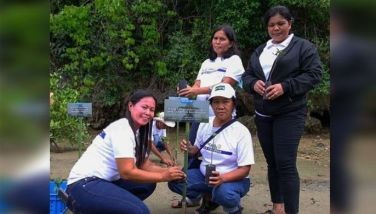Georg Joseph Kamel, SJ (1661-1706): First biodiversity scientist in RP
January 4, 2007 | 12:00am
Camellias are one of the most sought after ornamental plants. While not very fragrant, the blooms are spectacular. These flowers are grown by plant fanciers worldwide, especially in its native land, China and Japan. There are many cultivars of camellias, one of which is named after the Philippines’ national hero, Jose Rizal.
While many people are familiar with camellias, very few know that the plant genus is named after a Jesuit lay brother missionary who worked in the Philippines from 1688 until his death in 1706. Georg Josef Kamel arrived in the Philippines in 1688 and spent the remaining part of his life describing the taxonomy and systematics of Philippine plants and animals as part of his scientific practice of pharmacy and medicine. To understand the world in which Kamel did his work, we have to recall that during this time in history, the medical sciences were just emerging from medieval superstition and alchemy. Kamel, who trained as a botanicus et apothecarius (botanist and pharmacist) in the Jesuit College in Brünn, Moravia (now Brno, the Czech Republic), was one of the first medical practitioners to use science in the treatment and management of disease.
Kamel’s scientific work in the Philippines cannot be understood without reference to pharmacy. European colonists in Asia and tropical America had to contend with unfamiliar diseases for which drugs from native plant sources were needed. The Jesuit historian Murillo Velarde describes how Kamel went about his task of dispensing medicines made from Philippine plants. He experimented on new formulations and noted the right dose for his patients through experiment. His success in treating diseases and concern for the poor made him beloved by the citizens of Manila.
From his arrival in 1688, Kamel began collecting and describing Philippine plants. In 1698 he shipped specimens and botanical reports to England but these were lost at sea which Kamel regretted. His reputation as a physician and pharmacist was well known even to the British in India. Kamel published his book entitled Herbarum Aliarumrque stirpium in insula Luzon e Philippinarum from 1697 to 1698. Copies of this book which we know now as the Herbarum Philippinarum in three volumes were sent to the eminent English naturalist John Ray in 1698 through an English medical doctor in Madras. This was lost together with Kamel’s botanical specimens that year. The following year, he sent another volume and this was the one published as an appendix to John Ray’s Historia Plantarum of 1704. This is how Kamel became an internationally renowned scientist.
Herbarum is Kamel’s major contribution to science. Parts of the Herbarum were published in the Philosophical Transactions of the Royal Society by another eminent English naturalist, John Petiver. Kamel’s work on Philippine natural history went beyond botany. He wrote scientific papers on birds, corals, fish, crustaceans, and large animals entitled de Monstris et Monstruosis; quadrupeds, Turbinid mollusks, Bivalvus et Univalvus; insects and fossils. These works are evidence of the keen interest that Kamel had on biodiversity.
Among the more significant papers Petiver published in the Transactions is the one entitled De Igasur seu Nox Vomica Legitima Serapionis subtitled, "An account of the virtues of Faba St Ignatii." This paper relies on Kamel’s description of the Saint Ignatius bean, a plant that is the source of strychnine. Kamel noted that this poison in low doses has medical properties. When he first collected this plant, he noted its distribution – its absence in Luzon but existence in abundance in Samar. The plant is named after the Jesuit order’s founder since it was first collected in Jesuit mission territories in the Philippines. Kamel was also interested in ethnobotany. He recorded the local names of Philippine plants from Luzon and even from the Visayas and Mindanao. Linnaeus noted this important fact in his works.
Kamel was foremost a scientist. His skepticism regarding numerous myths has been recorded. In the colonial Philippines of the late 1600s, praying mantises were believed to arise from leaves and twigs became worms. Kamel said, "I do not accept this because I have observed that the sexes are distinguished and the young are born from eggs."
The world now remembers Kamel for camellias. Linnaeus renamed the plant from the original genus Thea to Camellia in his honor. History does not record whether Kamel sent a specimen of the plant to any botanist in Europe at the time. This was unlikely since Kamel never went to China and Japan. There is no record that Jesuit missionaries in these countries ever sent Kamel a specimen. Linnaeus also never received a specimen from Kamel since Kamel died a year before he was born. Linnaeus named the plant simply in honor of Kamel’s excellent work in botany.
Kamel died on May 2, 1706 in the San Ignacio College in Intramuros apparently of dysentery. He was 45 years old. He was buried in the first San Ignacio Church (a site now occupied by the Pamantasan ng Lungsod ng Maynila). This church no longer exists and fell into ruin after the expulsion of the Jesuits from the Philippines in 1768.
What does Kamel’s life teach us about how science is done? While the historian Leo A. Cullum emphasizes Kamel’s religious vocation, he also writes that Kamel placed his scientific work fully within his apostolate and the Christian virtues of charity and humility. Thus he writes: "Even the science he had loved without loving himself in it, playing an obscure role of unselfish charity with the poor at his door and the English savants of the Royal Society."
However, we can also learn from Kamel’s life that science is essentially a communication and collaborative activity that transcends nationality and religion. This is why he corresponded with the leading scientists of his time. It is true that he did not have sole authorship of any of his works and he was content to collaborate with other scientists. Perhaps he viewed his scientific work in the context of his Catholic missionary work. Nonetheless, his scientific skills were clearly recognized and cited. Kamel’s science teaches us that proper documentation and international publication, then as now, are the key to scientific credibility and progress. Kamel also shows us perseverance as a key scientific virtue. He was not discouraged by the loss of his scientific specimens and publications. (A year later he rewrote his manuscript and sent them again.) He challenged the medical and natural history myths of his time by experimentation and empirical observations. Aside from his botanical work, today he is remembered as one of the earliest exponents of pharmacy as a science. It is for this reason that the Czech Republic, UNESCO and his hometown of Brno commemorated his 300th death anniversary last May 2.
However, in the Philippines where he did much of his science, Kamel has all but been forgotten. I hope this essay makes some amends for our neglect of his memory. Even if I may be criticized for doing so, I call Kamel the first Filipino biodiversity scientist. Yes, he was Czech, but I cannot help but recall another "alien" Jesuit in the 1950s in the Philippines, Fr. John P. Delaney, who famously asked the regents of the University of the Philippines, "How much more should a man give before he becomes one of you?" I think in Kamel’s case the answer is clear. He gave so much to the Philippines and its people. This first biodiversity scientist is certainly a Filipino.
Benjamin Vallejo Jr., PhD, is an assistant professor of environmental science at the University of the Philippines Diliman. His research and teaching interests are in biogeography and the evolution of Philippine biodiversity. He can be reached at bmvallejo@up.edu.ph
While many people are familiar with camellias, very few know that the plant genus is named after a Jesuit lay brother missionary who worked in the Philippines from 1688 until his death in 1706. Georg Josef Kamel arrived in the Philippines in 1688 and spent the remaining part of his life describing the taxonomy and systematics of Philippine plants and animals as part of his scientific practice of pharmacy and medicine. To understand the world in which Kamel did his work, we have to recall that during this time in history, the medical sciences were just emerging from medieval superstition and alchemy. Kamel, who trained as a botanicus et apothecarius (botanist and pharmacist) in the Jesuit College in Brünn, Moravia (now Brno, the Czech Republic), was one of the first medical practitioners to use science in the treatment and management of disease.
Kamel’s scientific work in the Philippines cannot be understood without reference to pharmacy. European colonists in Asia and tropical America had to contend with unfamiliar diseases for which drugs from native plant sources were needed. The Jesuit historian Murillo Velarde describes how Kamel went about his task of dispensing medicines made from Philippine plants. He experimented on new formulations and noted the right dose for his patients through experiment. His success in treating diseases and concern for the poor made him beloved by the citizens of Manila.
From his arrival in 1688, Kamel began collecting and describing Philippine plants. In 1698 he shipped specimens and botanical reports to England but these were lost at sea which Kamel regretted. His reputation as a physician and pharmacist was well known even to the British in India. Kamel published his book entitled Herbarum Aliarumrque stirpium in insula Luzon e Philippinarum from 1697 to 1698. Copies of this book which we know now as the Herbarum Philippinarum in three volumes were sent to the eminent English naturalist John Ray in 1698 through an English medical doctor in Madras. This was lost together with Kamel’s botanical specimens that year. The following year, he sent another volume and this was the one published as an appendix to John Ray’s Historia Plantarum of 1704. This is how Kamel became an internationally renowned scientist.
Herbarum is Kamel’s major contribution to science. Parts of the Herbarum were published in the Philosophical Transactions of the Royal Society by another eminent English naturalist, John Petiver. Kamel’s work on Philippine natural history went beyond botany. He wrote scientific papers on birds, corals, fish, crustaceans, and large animals entitled de Monstris et Monstruosis; quadrupeds, Turbinid mollusks, Bivalvus et Univalvus; insects and fossils. These works are evidence of the keen interest that Kamel had on biodiversity.
Among the more significant papers Petiver published in the Transactions is the one entitled De Igasur seu Nox Vomica Legitima Serapionis subtitled, "An account of the virtues of Faba St Ignatii." This paper relies on Kamel’s description of the Saint Ignatius bean, a plant that is the source of strychnine. Kamel noted that this poison in low doses has medical properties. When he first collected this plant, he noted its distribution – its absence in Luzon but existence in abundance in Samar. The plant is named after the Jesuit order’s founder since it was first collected in Jesuit mission territories in the Philippines. Kamel was also interested in ethnobotany. He recorded the local names of Philippine plants from Luzon and even from the Visayas and Mindanao. Linnaeus noted this important fact in his works.
Kamel was foremost a scientist. His skepticism regarding numerous myths has been recorded. In the colonial Philippines of the late 1600s, praying mantises were believed to arise from leaves and twigs became worms. Kamel said, "I do not accept this because I have observed that the sexes are distinguished and the young are born from eggs."
The world now remembers Kamel for camellias. Linnaeus renamed the plant from the original genus Thea to Camellia in his honor. History does not record whether Kamel sent a specimen of the plant to any botanist in Europe at the time. This was unlikely since Kamel never went to China and Japan. There is no record that Jesuit missionaries in these countries ever sent Kamel a specimen. Linnaeus also never received a specimen from Kamel since Kamel died a year before he was born. Linnaeus named the plant simply in honor of Kamel’s excellent work in botany.
Kamel died on May 2, 1706 in the San Ignacio College in Intramuros apparently of dysentery. He was 45 years old. He was buried in the first San Ignacio Church (a site now occupied by the Pamantasan ng Lungsod ng Maynila). This church no longer exists and fell into ruin after the expulsion of the Jesuits from the Philippines in 1768.
What does Kamel’s life teach us about how science is done? While the historian Leo A. Cullum emphasizes Kamel’s religious vocation, he also writes that Kamel placed his scientific work fully within his apostolate and the Christian virtues of charity and humility. Thus he writes: "Even the science he had loved without loving himself in it, playing an obscure role of unselfish charity with the poor at his door and the English savants of the Royal Society."
However, we can also learn from Kamel’s life that science is essentially a communication and collaborative activity that transcends nationality and religion. This is why he corresponded with the leading scientists of his time. It is true that he did not have sole authorship of any of his works and he was content to collaborate with other scientists. Perhaps he viewed his scientific work in the context of his Catholic missionary work. Nonetheless, his scientific skills were clearly recognized and cited. Kamel’s science teaches us that proper documentation and international publication, then as now, are the key to scientific credibility and progress. Kamel also shows us perseverance as a key scientific virtue. He was not discouraged by the loss of his scientific specimens and publications. (A year later he rewrote his manuscript and sent them again.) He challenged the medical and natural history myths of his time by experimentation and empirical observations. Aside from his botanical work, today he is remembered as one of the earliest exponents of pharmacy as a science. It is for this reason that the Czech Republic, UNESCO and his hometown of Brno commemorated his 300th death anniversary last May 2.
However, in the Philippines where he did much of his science, Kamel has all but been forgotten. I hope this essay makes some amends for our neglect of his memory. Even if I may be criticized for doing so, I call Kamel the first Filipino biodiversity scientist. Yes, he was Czech, but I cannot help but recall another "alien" Jesuit in the 1950s in the Philippines, Fr. John P. Delaney, who famously asked the regents of the University of the Philippines, "How much more should a man give before he becomes one of you?" I think in Kamel’s case the answer is clear. He gave so much to the Philippines and its people. This first biodiversity scientist is certainly a Filipino.
BrandSpace Articles
<
>
- Latest
Latest
Latest
January 10, 2025 - 12:25pm
By Nic Satur Jr. | January 10, 2025 - 12:25pm
December 16, 2024 - 10:38am
December 16, 2024 - 10:38am
December 2, 2024 - 6:19pm
December 2, 2024 - 6:19pm
October 25, 2024 - 9:00am
October 25, 2024 - 9:00am
October 24, 2024 - 11:20am
October 24, 2024 - 11:20am
Recommended

























